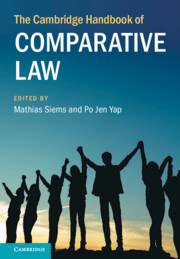Out now: The Cambridge Handbook of Comparative Law (by Siems and Jen Yap)
There is no doubt that private international law works in close cooperation with comparative law. Horatia Muir Watt, for example, characterises the relationship between the two disciplines as “complementary” (H M Watt, “Private International Law”, in J M. Smits (ed.), Elgar Encyclopedia of Comparative Law (2nd ed., Edward Elgar Publishing, 2012) p. 701). Similarly, Mathias Reimann describes it as “intimate” (M Reimann, “Comparative Law and Private International Law”, in M Reimann and R Zimmermann (eds.), The Oxford Handbook of Comparative Law (2nd ed., OUP, 2019) p. 1340). Meanwhile, Ralf Michaels, another distinguished scholar of comparative and private international law, considers that “in private international law scholarship, comparison has always been prominent” (Ralf Michaels, “Comparative Law and Private International Law”, in J Basedow et al. (eds.), Encyclopedia of Private International law –Volume I (Edward Elgar Publishing, 2017) p. 416).
Understanding foreign legal systems and the diversity of the solutions dealing with common problems and issues has always been crucial for private international law scholars and researchers. This enables them to refine the techniques and theories of private international law, and ultimately serves one of the most important goals of private international law: the coordination of different legal systems.
This elaborate introduction serves to justify the announcement on this blog regarding the recently published Cambridge Handbook of Comparative Law (CUP, 2024), edited by Mathias Siems (European University Institute, Florence) and Po Jen Yap (The University of Hong Kong).

The book’s description reads as follows:
Comparative law is a common subject-matter of research and teaching in many universities around the world, and the twenty-first century has aptly been termed ‘the era of comparative law’. This Cambridge Handbook of Comparative Law presents a truly global perspective of comparative law today. The contributors are drawn from all parts of the world to provide different perspectives on how we understand the ‘law’ and how it operates in practice. In substance, the Handbook contains 36 chapters covering a broad range of topics, divided under the following headings: ‘Methods of Comparative Law’ (Part I), ‘Legal Families and Geographical Comparisons’ (Part II), ‘Central Themes in Comparative Law’ (Part III); and ‘Comparative Law beyond the State’ (Part IV).
The book’s table of content is accessible here.
One can read with a lot of interest the contribution of Yuko Nishitani (Kyoto University) in this book on “Comparative Conflict of Laws” (pp. 674-692). The chapter’s summary is as follows:
Conflict of laws (or private international law) deals with cross-border legal relationships involving private parties. Methods of modern conflict of laws originate in Europe and largely remained intact until today despite modifications brought about by the US Conflicts Revolution. Other parts of the world, that is, Latin America, Asia and Africa, have not been on the centre stage. Even the recent globalisation discourse on legal pluralism and conflict of laws has principally focused on Western, developed countries, although the wave of globalisation affects the entire world. Countries in the Global South have been invisible presumably because, as former colonies, they are not readily accessible, are presumed not to have sophisticated conflicts rules, or are deselected by the choice of forum/arbitration clauses in cross-border business transactions. This chapter will deal with comparative conflict of laws from a non-Western viewpoint. This stance will allow for the relativising of the trends of conflict of laws in Europe and America and shed light on the recent debates on corporate due diligence and Sustainable Development Goals (SDGs) in conflict of laws by considering interests of the most affected and vulnerable people in the Global South. This chapter will also discuss future developments of conflict of laws treaties, which Asian and African countries have rarely joined so far.